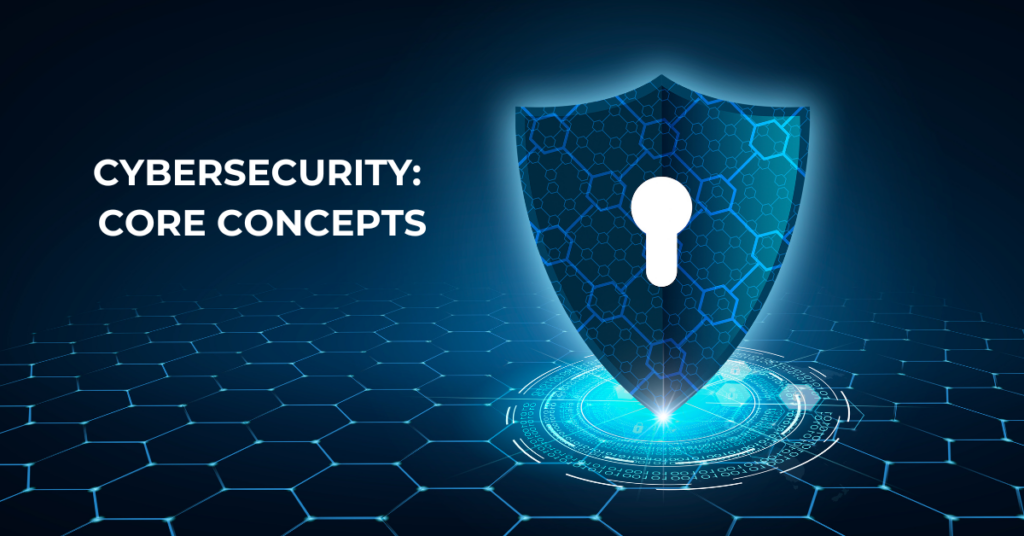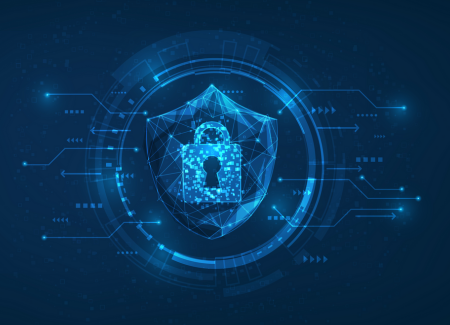A Guide to Cybersecurity Concepts: Know Its 10 Key Terms

- Frequently Asked Questions
According to the India Cyber Threat Report 2023 by the Data Security Council of India, over 400 million malware and ransomware attacks were detected in the country in 2023. Due to rising cybersecurity threats, organizations are investing in cybersecurity tools and antivirus software. However, cybersecurity professionals require a thorough knowledge of network security concepts to implement the tools and practices. This blog discusses cybersecurity concepts, including cybersecurity principles and network security principles.
 What are the Fundamental Cybersecurity Concepts?
What are the Fundamental Cybersecurity Concepts?
Key Terms in Cybersecurity
Let’s understand common terms or phrases to learn cybersecurity concepts.
1. Malware
This is one of the most cybersecurity basic concepts. It means any malicious software or program that can harm a computer or network system, leading to data loss or misuse. Furthermore, the most popular malware are viruses, worms, ransomware, trojan horses, bots, and spyware.
2. Firewall
It’s one of the most fundamental network security concepts, and it refers to a security device or system that monitors inward and outward traffic. Moreover, firewalls prevent traffic from unauthorized users accessing the network.

3. Advanced Persistent Threat (APT)
It’s a prolonged or continuous cyberattack in which an intruder secretly enters the system. They stay there for a long time to gather confidential information.
4. Botnet
This malware hijacks a computer device to perform instructions provided remotely by the hacker.
5. Distributed Denial of Service (DDoS)
DDoS is a type of cyberattack in which the attacker floods a server with huge volumes of traffic. Therefore, it impacts the network bandwidth and crashes the server. Consequently, users are unable to connect to the server.
6. Identity and Access Management (IAM)
Cybersecurity policies, frameworks, and technologies that determine user identity and user access to data are collectively called identity and access management.
7. Penetration Testing
It is a simulated cyberattack by an organization in which external users attack the system to detect vulnerabilities.
8. Asset
It is essential to understand the meaning of assets to learn cybersecurity concepts. So, A cybersecurity asset refers to valuable hardware, software, or information. Furthermore, it includes intellectual property, customer records, business plans, cloud networks, IoT devices, domains, modules, and network interfaces.
9. Trojan Horse
It is a type of malware that is a legitimate code. However, once it enters the system, it can attack files, steal confidential information, or perform other harmful activities.
10. Brute Force Attack
It’s one of the most common cybersecurity concepts. Furthermore, a brute force attack involves hacking a system by guessing the password through trial and error.
ALSO READ: What is Cyber Law and Why is It Important? Top 10 Types and Objectives
Cybersecurity Tools
Here are some of the most popular tools for familiarizing yourself with cybersecurity concepts.
1. Next-Generation Firewalls
These firewalls perform advanced functions in comparison to traditional firewalls. Primarily, their activities include blocking or filtering traffic, application control, and threat intelligence.
2. Vulnerability Scanning Tools
Vulnerability scanning tools scan networks, systems, or applications to detect vulnerabilities or security weaknesses. This enables organizations to strengthen their security systems. Simultaneously, these tools also recommend strategies to reduce vulnerabilities.
3. Encryption Tools
These tools encrypt confidential or sensitive information into codes so hackers cannot read the information. Therefore, these tools facilitate secured data transfer.
4. Antivirus Software
Antivirus software is the fundamental security program that protects computer systems by detecting, deleting, and preventing viruses.
5. Packet Sniffers
These tools are used for packet sniffing, a cybersecurity practice that analyzes data packets sent across a network. Therefore, professionals use packet sniffers to detect IP addresses or bandwidth usage. Hence, these tools help detect suspicious activities.
ALSO READ: How Secure Coding Practices Help Mitigate Cybersecurity Threats
Cybersecurity Principles and Practices
A cybersecurity framework comprises principles and practices that serve the following five purposes:
- Governance: Identifying assets and vulnerabilities
- Protection: Implementing cybersecurity concepts and measures and network security principles to mitigate or control cybersecurity risks
- Detection: Recognize the occurrence and the type of cybersecurity events
- Respond: Taking action against cybersecurity attacks to reduce its impact
- Recover: Promptly recovering data impacted during a cybersecurity incident
The most popular cybersecurity principles are:

1. C-I-A Triad
The Confidentiality, Integrity, and Availability (CIA) triad is one of the major cybersecurity basic concepts used to create organizational policies. It is a model that emphasizes keeping important data confidential by allowing authorized users to access it. Moreover, data should be stored properly to ensure its authenticity. Further, this principle also focuses on making data readily available to authorized users.
2. Economy of Mechanism
This means keeping the design and implementation of the security mechanism simple. This principle, therefore, reduces the attack surface and makes testing easier.
3. Fail-Safe Defaults
This is one of the key cybersecurity concepts that means that access to a network or application should be denied by default unless explicitly granted by an authorized person. Therefore, this principle prevents unauthorized access.
4. Complete Mediation
It refers to verifying every attempt to access a network. For example, if a user exits an application or website, they will have to log in again whenever they want to access the application. Thus, it prevents the caching of information.
5. Open Design
The open design principle states that security systems should be open to audits and analysis by cybersecurity experts.
6. Incident Management
It has become one of the most fundamental cybersecurity concepts in the modern world. Incident management refers to constantly monitoring networks and systems to detect cybersecurity events in real time.
7. Assign Minimum Privileges
It is one of the fundamental cybersecurity principles used in security design. Furthermore, assigning minimum privileges means allowing users access to only the most necessary items required to perform tasks. For example, an application for processing images should have access to only the required images.
8. Layering
This practice involves adding multiple security levels or layers to protect the most vulnerable assets. For example, adding multi-factor authentication or remote browser isolation makes it difficult for hackers to breach the system. Thus, layering provides additional defense.
ALSO READ: Ethical Hacking vs. Cyber Security: Important Differences You Should Know About
Frequently Asked Questions
1. How Do Encryption and Authentication Play a Role in Cybersecurity?
Encryption refers to locking or encoding data using encrypted keys. Therefore, data can be only accessed by users with the decryption key. Moreover, data becomes hidden or inaccessible to unauthorized users. Additionally, authorization means verifying the identity of users attempting to access a network or system. Therefore, they protect organizations’ assets.
2. What are the Key Principles of Network Security?
The key network security concepts and principles involve confidentiality, authentication, access control, and data integrity.
3. How Does Risk Management Contribute to Cybersecurity?
Cybersecurity attacks are inevitable. However, organizations can reduce their impact through effective risk management. It involves assessing an organization’s assets, identifying vulnerabilities, and implementing appropriate solutions to mitigate cybersecurity risks.
4. What is the Importance of Incident Response in Cybersecurity?
Incident response means actively detecting and controlling cyberattacks. Therefore, it prevents the loss of confidential data, facilitates quick data recovery, and reduces financial loss. It enables organizations to maintain public trust and adhere to regulatory compliances.
Due to technological advancement, cybersecurity attacks are one of the biggest threats to organizations. Therefore, organizations increasingly invest in cybersecurity frameworks, tools, and resources. Hence, the cybersecurity career is booming. Emeritus’ online cybersecurity courses can help you build a promising career in this field by teaching cybersecurity concepts and skills.
Write to us at content@emeritus.org




